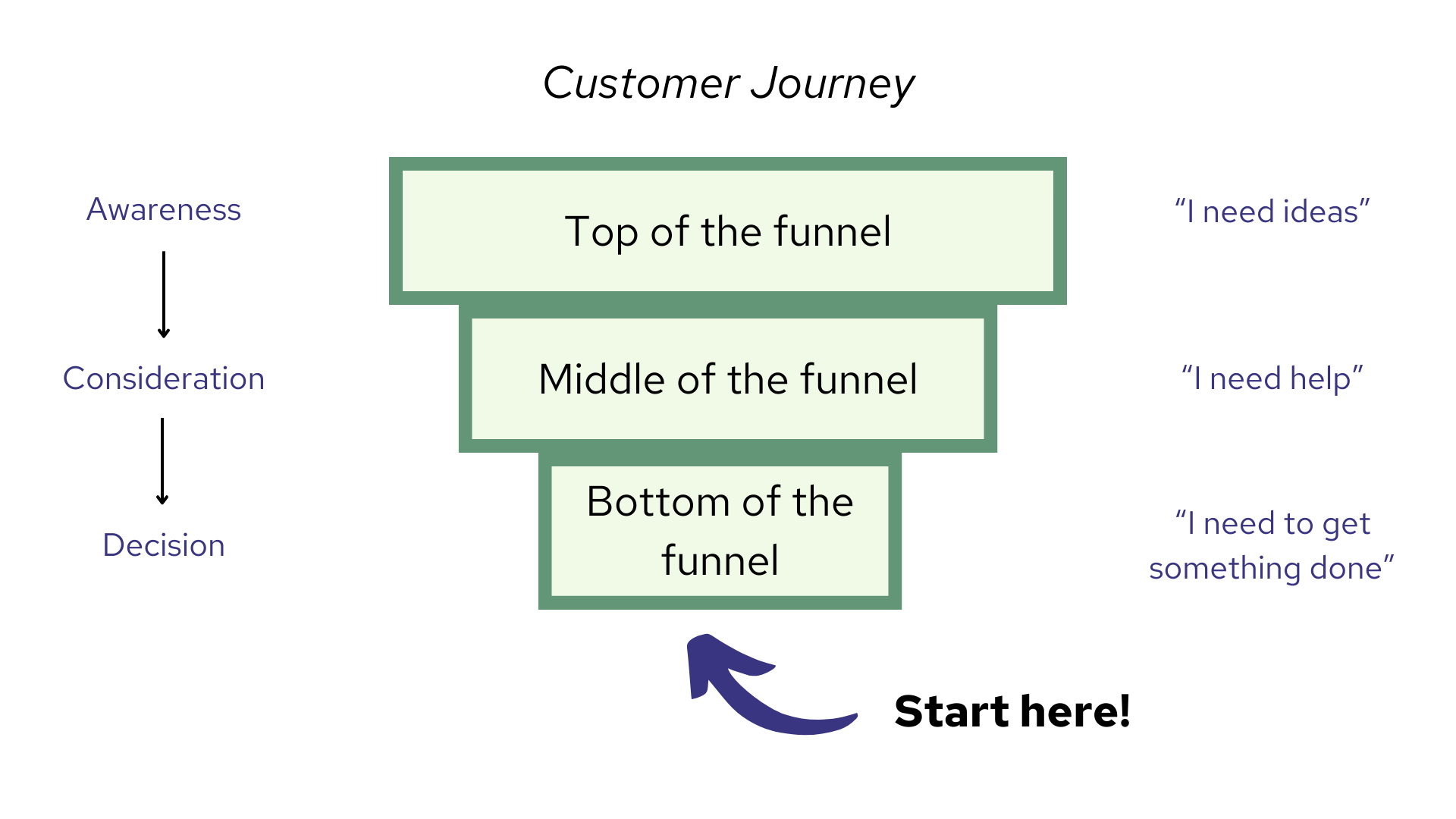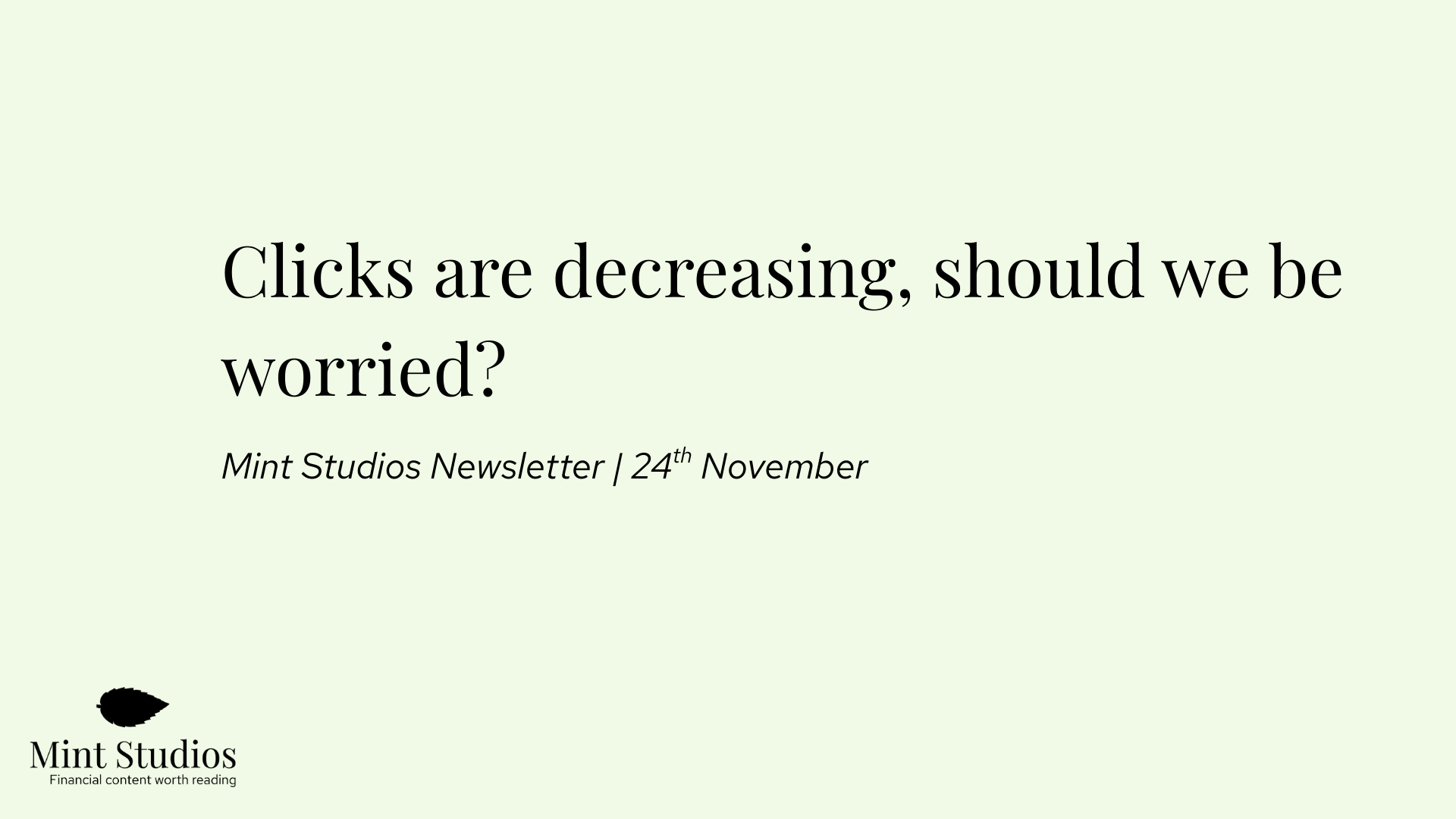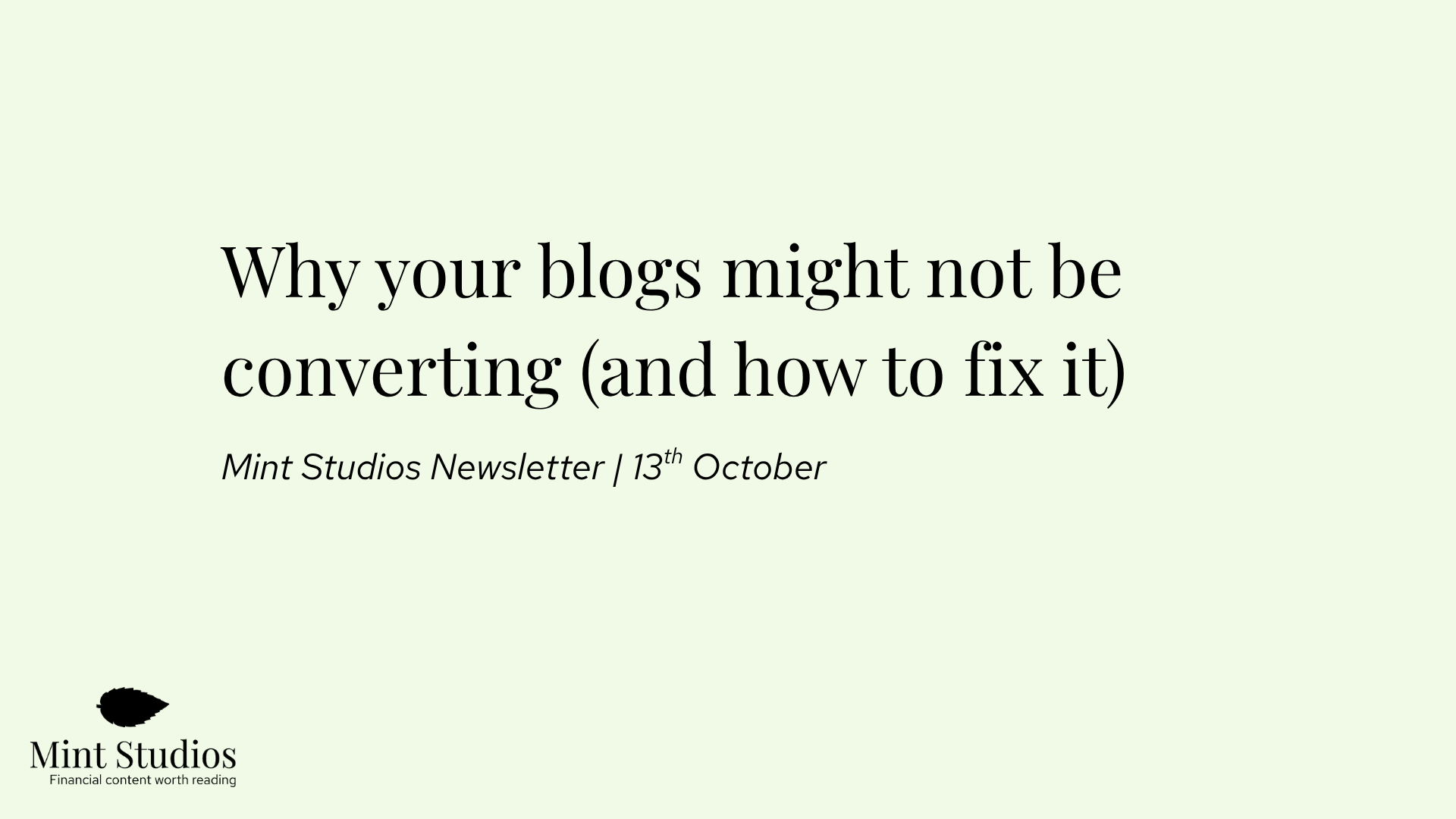Imagine you’re tracking all your content correctly and are now able to see how many leads and customers your articles are generating — down to the specific blog post.
But after doing a few calculations, you realise that… the numbers are not good. Considering the investment you’re putting into content, the conversions are too low and the ROI is either negative or not high enough.
How do you fix that?
No amount of tracking and optimization will be able to fix bad content that misses the mark. Which is why if you’re not getting the conversions, it might be time to go back to the drawing board.
Here are a few reasons why your conversions may be down on a specific article, and some ideas and steps to fix each one:
1. Your content isn’t focused on conversions
The first question to ask yourself is: is our content focused on Bottom of the Funnel? Meaning, are you writing articles that are targeting people who are ready to buy your product?
If you are writing articles like “10 ways to save money” and “4 tips to improve your customer experience”, then it’s no surprise your content is not generating conversions (although this is not always the case, Top of the Funnel works well for services business, for example). Here’s a diagram illustrating the funnel:

Many people will start creating content that targets customers at the “awareness” stage. Although eventually it makes sense to create this type of content, at Mint Studios we argue that you should start with the “decision” stage. Why? Because these are where your best customers are: those who already know they have a problem, know the solution and are ready to buy. They are low hanging fruit, which means it makes sense to target those first.
If none of your articles are Bottom of the Funnel (BOFU), then your conversion rate will be low. Some quick wins are to write BOFU articles on the following 5 topics:
- “Best of X category” (e.g. Best investment apps)
- “Competitor A vs Competitor B” (e.g. Robinhood vs eToro)
- Pain points (e.g. Investment app with no fees)
- Use cases (e.g. Investment app for beginners)
- Pricing (e.g. Robinhood fees)
If you have more time and want to invest in content long term, then it’s time to do research in order to write high quality BOFU content. Sit down with the product team, customer success team, founder and do some research into pain points, use cases and take the time to understand what your target market is searching online to find your solution (we’ll soon be writing an article on how to do that kind of research — join the newsletter to get an update!).
Emma Westley, founder of immerj, also says:
“Not understanding the pain point correctly, or trying to tackle too many pain points in the one piece of content Both result in confusion for the customer and reflect badly on the brand”
Once you start producing Bottom of the Funnel articles, you’ll see conversion rates increasing.
2. Your content is written for the wrong audience
If your article is titled “Lending solutions for payment processors”, but then starts off with “what is a payment processor?” and “types of lending solutions”, then it’s highly likely your target audience won’t continue reading.
If you’re writing for an advanced audience, writing beginner style articles is a good way to turn them off. Sure, you’ll get pageviews and may rank on Google, but the people you are targeting won’t be reading your content.
This is a mistake we see a lot in the B2B financial services world. Although you’re targeting CFOs, CEOs and Heads of Sales, you’re writing beginner articles on “What is payment processing” and “6 tips for strategic planning”.
Instead of writing articles for a beginner audience, write for your target audience. How do you know what they want to read? That’s when sitting down with your Head of Sales, Product and SEO to understand pain points is important.
Start with content that answers their most pressing questions. Then, interview the experts on your team on these advanced topics. Your target audience will actually learn something new and respect the fact that you know what you’re talking about. They’re more likely to keep reading, and therefore more likely to convert.
Don’t write this type of content 👇

3. Your articles are too long winded and full of fluff
One key thing about Bottom of the Funnel articles is that they should be direct and to the point. Someone who is researching “best investment apps” wants a list of top investment apps and then a clear button with information as to which one they should pick. They probably don’t need to read “what is an investment app”, or “why download an investment app”. They want answers to their questions, and they want it to be clear.
Many bad SEO articles out there are full of fluff and don’t get to the point. Introductions are long winded and full of cliches, paragraphs are full of jargon and unnecessary words, and conclusions take up too much space.
The point is, these are articles to sell. We’re writing to sell. Which means you need to keep the reader hooked, give them the information and make it as easy as possible to convert into a customer.
That’s why, at Mint Studios, we don’t start writing articles immediately. Instead, our writers fill in a short questionnaire that helps them put themselves in the readers shoes and helps them understand: what are the pain points, how do these connect to the product features and what information do they want? Only once this is agreed and understood, do we start writing.
If you fall asleep reading the articles on your website’s blog, then it could be the writing style. Head to our Method section to see examples of articles that we write for clients that are punchy, to the point and don’t have fluff.
Also, we recommend reading this: How to Write an Introduction That Converts
4. Your blog posts are not ranking high enough on Google
Your article might be high quality, to the point and very BOFU — but if it’s in position 12, then it won’t be noticed. The biggest sign that this is the issue is that your organic traffic is low as well. This type of issue is very common for new websites with low authority.
In this case, your challenge is SEO related: how do you get your article to rank higher on Google?
There are a few ways to do this. On our end, we like to go through this process:
- Optimise the blog post: are you sure you are matching intent? Is it easy to read? Does it have all the relevant information? Go through the “People also ask” section on Google and add more information (where it makes sense)
- More content distribution. Try to build backlinks to the articles. This could be through guest posts, or through influencer marketing. Promote it in groups where the content is relevant.
- Make sure all your technical SEO is in order. Does the article have large images? Does it take 3 seconds to load? Is Google Search Console reporting that it’s being crawled and tracked?
- Wait. SEO takes time. If your website is new and you’ve only been publishing for 3 months, then you likely need to wait. We usually see SEO taking between 6 and 10 months to start working.
Beth Gladstone, freelance Content Marketing Strategist, also has a good point regarding duplicate content:
“A reason I see is lots of thin, duplicate content - multiple blogs or pages on the same topic so Google isn't sure which is your key piece for that term/intent and as a result, you get 4 or 5 pieces all ranking in positions 35 - 45 and no real traction on any of them.”
5. You’re not offering the reader enough opportunities to convert
For every BOFU blog post we create, we add at least two Call to Actions on the article. One right after the intro (this way people who don’t want to read and just sign up, sign up), and one right at the bottom. We also add them in the middle wherever it makes sense and if it’s natural.
The point is: make sure you have CTAs in all the right places. Add internal links and “Read more” sections to keep the reader engaged.
You want to make it as easy as possible for the reader to convert. So make sure your CTA is visible and easy to click.
As Christina Pashialis, founder of Content UK, says:
“[A reason why your content is not converting could be] if you haven't thought about the structure of your post!
For example, if you have a CTA for a free trial for your tool, build up to this in your content. You could talk about a pain point, tips for solving this, how your tool helps solve this pain and then add in the CTA for a free trial”
Emma Westley says this is a common reason your content might not be converting:
“Not connecting the topic of your content with a definitive next step or CTA [could explain low conversions]. In other words, make it easy for the customer to know what to do next.”
6. Your blog post is ugly
It may seem trivial, but this is very important. Most people read on their phones, and bad blog formatting makes it hard to read articles.
Imagine that: you’ve got the perfect prospect and they’re ready to convert, but because your font is too small, light grey and you have five pop-ups, the reader can’t be bothered and decides to go back to the search results. Consumers are demanding: if the reading experience is uncomfortable, they won’t read the stellar article you wrote.
So we also always make sure formatting is set up. Usually, that means:
- 750px wide
- 20 font size at least
- Black font (or dark font)
- Paragraph breaks
- White background
It’s one of the first things we set up for clients when we begin work. If it’s comfortable and easy to read, people are more likely to read it and therefore more likely to convert.
Whenever your conversions are low, go through this checklist to try and identify the problem. That’s what we do whenever we see that conversions are low and traffic is high. Then, test a few things and see what happens. As with many things in marketing, a lot of it comes down to experimenting. Add a table of contents, add a case study, change the structure of the post, and see what happens. With BOFU, high quality content focused on your target market pain points, you’ll eventually manage to increase your conversions.
Want to learn more about what we do? Learn more about the Mint Studios framework.











